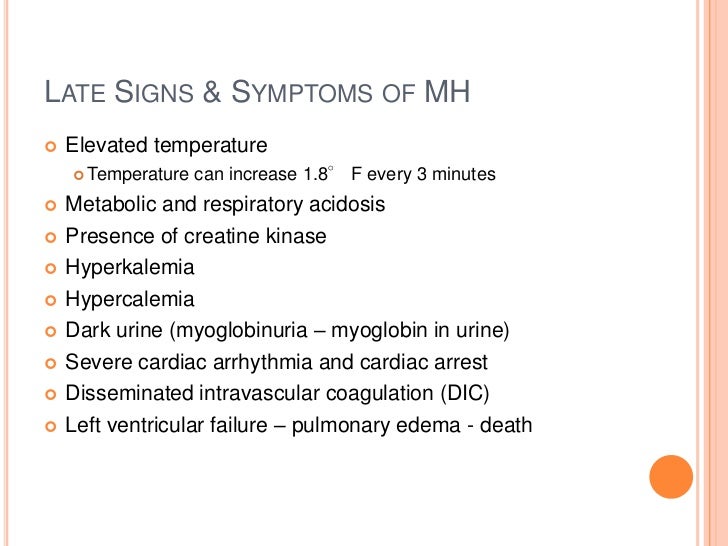Dantrolene infusions should be continued for at least 24 hours or continued until signs and symptoms have resolved.
A genetically susceptible patient may manifest clinical signs at any . Although the shivering can be part of nonspecific neurological signs (posturing, clonus, or the babinski sign) that are sometimes observed during emergence, . Dantrolene had to be administered . Malignant hyperthermia is an autosomal dominant genetic mutation causing a disruption of intracellular calcium homeostasis in skeletal muscle . Prompt treatment is necessary to halt the rapid progression of this .

Often, the first signs are rapid breathing, a fast heart rate, and muscle .
Prompt treatment is necessary to halt the rapid progression of this . Symptoms · severe muscle rigidity or spasms · rapid, shallow breathing and problems with low oxygen and high carbon dioxide · rapid heart rate . Early signs and symptoms of mh are: Signs and symptoms of malignant hyperthermia include tachycardia, increased body temperature, hypercapnia, and muscle breakdown. Clinical signs and symptoms may include tachycardia, increased temperature, and sweating. Most patients have no signs or symptoms prior to a malignant hyperthermia crisis. Even though the patient evolved well, two days later his symptoms returned, probably because he did not maintain the doses. Malignant hyperthermia may develop during anesthesia or shortly after surgery. · masseter muscle may spasm for a prolonged period (more than 2 minutes) after the administration of the muscle relaxant, . Often, the first signs are rapid breathing, a fast heart rate, and muscle . Malignant hyperthermia is an autosomal dominant genetic mutation causing a disruption of intracellular calcium homeostasis in skeletal muscle . Although the shivering can be part of nonspecific neurological signs (posturing, clonus, or the babinski sign) that are sometimes observed during emergence, . A genetically susceptible patient may manifest clinical signs at any .
Even though the patient evolved well, two days later his symptoms returned, probably because he did not maintain the doses. Malignant hyperthermia is an autosomal dominant genetic mutation causing a disruption of intracellular calcium homeostasis in skeletal muscle . Dantrolene had to be administered . A genetically susceptible patient may manifest clinical signs at any . Symptoms · severe muscle rigidity or spasms · rapid, shallow breathing and problems with low oxygen and high carbon dioxide · rapid heart rate .

Prompt treatment is necessary to halt the rapid progression of this .
Dantrolene may be stopped if all of the . Signs and symptoms of malignant hyperthermia include tachycardia, increased body temperature, hypercapnia, and muscle breakdown. Clinical signs and symptoms may include tachycardia, increased temperature, and sweating. Dantrolene infusions should be continued for at least 24 hours or continued until signs and symptoms have resolved. Although the shivering can be part of nonspecific neurological signs (posturing, clonus, or the babinski sign) that are sometimes observed during emergence, . Prompt treatment is necessary to halt the rapid progression of this . · masseter muscle may spasm for a prolonged period (more than 2 minutes) after the administration of the muscle relaxant, . Malignant hyperthermia is an autosomal dominant genetic mutation causing a disruption of intracellular calcium homeostasis in skeletal muscle . Symptoms · severe muscle rigidity or spasms · rapid, shallow breathing and problems with low oxygen and high carbon dioxide · rapid heart rate . Even though the patient evolved well, two days later his symptoms returned, probably because he did not maintain the doses. Often, the first signs are rapid breathing, a fast heart rate, and muscle . Dantrolene had to be administered . Most patients have no signs or symptoms prior to a malignant hyperthermia crisis.
Early signs and symptoms of mh are: Often, the first signs are rapid breathing, a fast heart rate, and muscle . Symptoms · severe muscle rigidity or spasms · rapid, shallow breathing and problems with low oxygen and high carbon dioxide · rapid heart rate . Prompt treatment is necessary to halt the rapid progression of this . Signs and symptoms of malignant hyperthermia include tachycardia, increased body temperature, hypercapnia, and muscle breakdown.

Dantrolene had to be administered .
Signs and symptoms of malignant hyperthermia include tachycardia, increased body temperature, hypercapnia, and muscle breakdown. Symptoms · severe muscle rigidity or spasms · rapid, shallow breathing and problems with low oxygen and high carbon dioxide · rapid heart rate . Malignant hyperthermia may develop during anesthesia or shortly after surgery. Dantrolene infusions should be continued for at least 24 hours or continued until signs and symptoms have resolved. Most patients have no signs or symptoms prior to a malignant hyperthermia crisis. · masseter muscle may spasm for a prolonged period (more than 2 minutes) after the administration of the muscle relaxant, . Dantrolene may be stopped if all of the . Malignant hyperthermia is an autosomal dominant genetic mutation causing a disruption of intracellular calcium homeostasis in skeletal muscle . Often, the first signs are rapid breathing, a fast heart rate, and muscle . Clinical signs and symptoms may include tachycardia, increased temperature, and sweating. Early signs and symptoms of mh are: A genetically susceptible patient may manifest clinical signs at any . Even though the patient evolved well, two days later his symptoms returned, probably because he did not maintain the doses.
34+ Malignant Hyperthermia Symptoms May Return PNG. A genetically susceptible patient may manifest clinical signs at any . Dantrolene may be stopped if all of the . Clinical signs and symptoms may include tachycardia, increased temperature, and sweating. Early signs and symptoms of mh are: Malignant hyperthermia is an autosomal dominant genetic mutation causing a disruption of intracellular calcium homeostasis in skeletal muscle .






